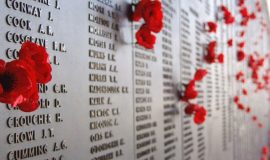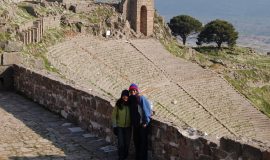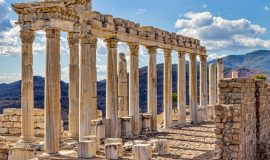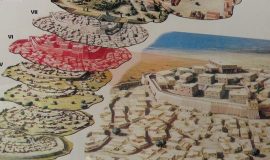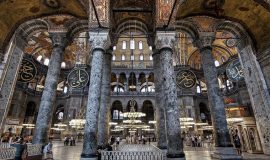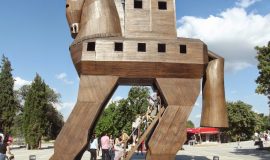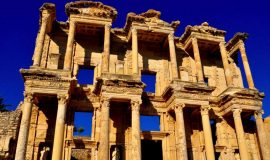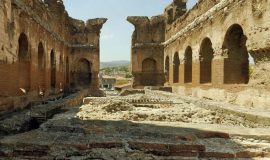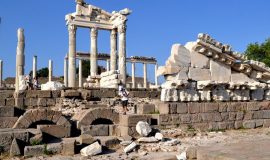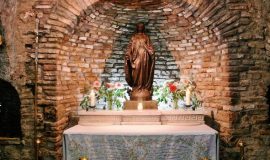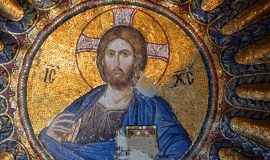
PERGAMON
Bergama is one of Turkey's most important cultural treasures. Pergamon is the cute town of Bergen, home to the remains of the ancient city, the centuries-old center of health, culture and art.
The remains of the ancient city of Bergama (Pergamon), one of Turkey's most important cultural treasures, are located in the district of Bergama, 29 kilometers east of the Dikili coast. The settlement is the point where the Kestel tea joins by carrying the waters of Bakırçay and the Deer Mountain to the North. The fertile soil carried by Bakırçay forms the Bakırçay Plain, where valuable products such as cotton, tobacco, grapes and olives are grown by Dikili.
In the history of the city of Pergamon we see the traces of the classical East-West study of Anatolia throughout the ages. Persians, Syrians, Arabs and Turks from the East, Greeks from the West, Isparta and Romans to these lands. They fought against each other to become sovereign. Information about the establishment of the city is unclear. However, according to the myths about the city's take-up, the King of Teuthrania Grynos asks for help from Pergamon in a battle and gives the name Pergamon to one of the cities he set up after victory.
However, the first records of the city are found in Anabasis (The Return of Ten Thousand) by Ancient writer and historian Ksenophon. Xenophon, Prince in power struggle against Persian King Artekserkses
He had fought with Artekserkses by going to Mesopotamia with an army of ten thousand people consisting of Ispartians, who was beside Kyros. Supported by the Isparta army as reported by Xenophon. Although this war ended with a victory, Kyros died and the Isparta army returned through the Black Sea. According to the information given in this book, M.O. In 399, the houses of Xenophon Beragama and the Pergamon Kalesi are taken from the Persian satrapy Asidates. After this date, Pergamon became the scene of many wars and tactics between Persians and Western civilizations. Then important turning points were Alexander the Great of BC. In 334, the conquest of Calik with the Battle of Granikos, Lysimakhos of Thracian ruler BC. The importance of the city to bring the state treasure here in the 3rd century can be listed in Philetairos' Seleukos period, where he established an almost independent state and the subsequent Eumenes period. But the city's brightest episode is Eumenes II (197-19 BC). The Kingdom was bound to Rome by Attalos' will in 133. Bergama is one of the most important cities of the Asian Province during the Roman period.
AKROPOLIS (Bergama) ANTIQUE CITY
The acropolis is built on an extremely steep hill. Approximately 300 m. It climbs up this hill at the height of a climbing road. In the city settlement called the acropolis, the religious, official, social and commercial buildings are interwoven within a specific plan framework. The Bergama King's Palace is on top of the hill, which has been the place of the insurgency since the early ages. Five cisterns and an ammunition were located on this hill. Athena Temple is located in the lower part of the buildings. There is also a library and the Temple of Trajan. The terraces below it are carefully placed on the Zeus porch. One of the steepest theaters in the world is also here. At the bottom is the Gymnasion and Demeter Temple.
Today's remains of PERGAMON include Acaropolis, a library of 200 thousand skulls, ten thousand theaters, palaces, Trajan Temple, Asklepion and Serapis temples. In IV. Asklepeion, founded in the 19th century, is the most important medical center and school of its time. The Acropolis, which contains important remains of the ancient city, means "Upper City". There are three separate settlements in the upper city on the acropolis hill. There are royal palaces, temples and water cisterns in the highest and sheltered place of the acropolis, where the elders of the city lived with the royal family.
BERGAMA CHURCH:
It is the only known kiln from the seven kings mentioned in the GOSPEL. The Bergamans called this church built with red bricks "RED HUNT". Hadrianus (117-138 BC) first performed for God named Serapis. The original name is "Serapien" which means "in the place, in the sky". It was later converted to a basilica.
ATHENA TEMPLE:
The Athena Temple, built on the terrace above the theater, measures 6x10 m. Column is a structure in the order of Dor. The west wing is partly at 1.20 m. It is protected to the height. The columns and architrave parts of the temple are still in the Berlin Museum. The fact that the most important temple of the city belongs to the goddess Athena is an established tradition of Western Anatolia as seen in İzmir, Miletus, Eriythrai, Foça and Assos.
ALLIANO:
In 1998, 18 km north-east of Bergama, a new cult center was unearthed in the center of the Paşa Ilıcası. But the problem is this: This cult center is located within the water collection area of Yortanlı Dam, which started its construction in 1993. The new cult center emerged is a new Asklepion dedicated to the health god Asklepios. Allianoi will be under 17 meters of water when the dam's water-holding process begins, and over time it will be covered with mud and slime. An initiative called Allionai Volunteers proposes an alternative project for the emancipation of this important history heritage.
LIBRARY:
The adjacent structure to the north of the Athena sanctuary is the remains of the famous Bergama library. In the past, the library, which was accessed from the upper floor of the gallery, Eumenes devrine belongs to 13.53X 15.35 m in size has a large reading room. 3.50 m in the library equipped with wooden shelves. Athena was sculpted in height. This statue is now in the Berlin Museum. II. The greatest competitor of the library, enriched during the Eumenes period, was the Alexandria Library.
PALESTINES:
The stoas surrounding the Athena temple and the remains of the palaces of the kings of Bergama immediately east of the library are located. These are two large peristyle houses with courtyards in the middle. The small house in the north, Attolos, is considered to have been built during the Eumenes period. The mosaic fragments found in the palaces are now hidden in the Berlin Museum.
ARSENALLER:
Arsenal, known as a military material store, is located at the northern end of the acropolis, 10 m. Beyond the Palaces and Trajaneun. It was down to the level. These are 5 long structures parallel to each other.
TRAJANEUM:
It is the highest terrace of the acropolis built for the Romanized Roman Emperor Trajan. There is no doubt that there was a Hellenistic period here before. The temple is surrounded by stones on three sides and is 68x58 m. It rises on a terrace of a size. Trajan and Hadrian's colosal marble sculptures were found in the temple. The works are in Berlin Museum.
THEATER:
The Bergama Theater is built on a steep slope and is one of the most beautiful architectural monuments of the Hellenistic period. The building which is the steepest theater of Western Anatolia is 10.000 person. Part of the stage was wood in the Hellenistic period. Only game days were set up and then removed again.
ARCHEOLOGY MUSEUM:
Bergama Archaeological Museum, which was established as a museum store in 1924, moved to its new building in 1936. The museum exhibits archeological artifacts dating from the Early Bronze Age to the Byzantine Period. Among the finds from ancient settlements in the vicinity are the examples of the Pergamon sculpture school, the Myrina terracottales which were found in the Archaic period from Pitane and Gryneion.
Temple of Dionysus:
Bergamas built this eye-catching temple in a special way to the north of the 250-meter theater terrace, rather than the whole trip. The temple is very well preserved along with the altar, and it is a prolly plant in the Ion order rising on a podium with a rich profile. This work influenced European Baroque architecture as well as the understanding of Roman art, as a result of taking a place at the end of a long way and collecting all the eyes on it. The original pieces belonging to the Hellenistic period and the Roman period are hidden in the Berlin Museum.
ZEUS SNAĞI:
ZEUS is the brightest era of Bergama II. It was built during Eumenes (197-1995). Altar Victory of the kingdom of Pergamon against Galatians is symbol. In the reliefs on either side of the altar are depictions of the battle of the gods with the gods and the legendary foundation of Bergama. The first excavations in Bergama began in 1874 by German road engineer Carl Human. "The return of Zeus Sergeant to Germany in the return yoke of the Lost Lair" which was prepared by the Ministry of Culture under the publication directorship of Umit Yaşar Gözüm is as follows:
".. In the first three years of the excavations made in Bergama after the excavation was granted in 1878, the state's three-quarters of the works were given to the Germans in exchange for the amount appreciated.As part of the works which were published in the fourth and fifth years of these excavations, It seems that it has been left to "... The attempts to recover the sunflower have been as inconclusive as the day. Today, many of the precious relics of Pergamon, which is exhibited in Pegamon Museum in Berlin, visit about 850 thousand people every year.
Athena Temple is 25 m on the lower terrace. . This place is approximately 69x77 m. And the great altar was rising in the midst of it. Probably the four sides of the window were open and the monument was easily seen from all over. All the architectural fragments and reliefs on the site, which can only be seen on the acropolis, are exhibited today in close proximity to the Berlin Museum.
AGORA:
South of the Zeus Sunagi is located in the Upper Agora. It belongs to the Hellenistic turn. The god of merchants was made in the style of Agora Dor of Hermes. On the western edge of the square are the foundations of the Demeter temple.
GYMNASIS:
The city of Bergama was a glorious Gymnasion with three separate terraces on top. From the inscriptions found, it was understood that the lower terraces belonged to the children, and the middle terrace belonged to the upper terrace of the youthfulness.
ASKLEPION:
Asklepios, known as the god of health and medicine, is one of the sons of Apollo. Aesklepion, which means the location of Asklepios, is a major health center in Bergama in the early ages. After a column of columns, come to Asklepion. Therapeutic forms in this area include medicinal water, mud cure, sports, theater and psychotherapy. The building on the left is the temple of Asklepios. On behalf of the god of health, M.S. Built in 150 AD by donations, the temple is covered with a dome and its walls are 3 m. Thick. Here, by using the sound of water and suggestions, the patients were healed.
BERGAMA is an art, science and health center that has conceived important discoveries in history. God of health and medicine Asclepios'a meaning of the location of Asklepion'a 820 m. It was reached by a path with a column in its length. Asklepion has three sides with stones and the east side is surrounded by various constructions. It is an area that is open to the
In Asklepion there are three pools or fountains for washing and drinking. The building on the left is the Temple of Asklepios. Surrounded by galleries on three sides, Asklepios is in the middle of the area with a vaulted and 80 m. There is a passage in its length. From this gate, the circle-shaped structure for medical treatment was passed. By using the voices and suggestions of the past, the patients were healed. One of the most important discoveries of Bergama is the "Pergaminai carte, or parchment," which means Pergamon paper, and the famous physician of ancient times is Galen de Bergamalı .The 10,000-seat theater in the city was built during the reign of Eumenes II.
SERAPİS TAPINAĞI:
The greatest structure of ancient Bergama is the temple built with red brick which the people call red courtyard and dedicated to the Egyptian gods. This temple is now in Bergama city.
